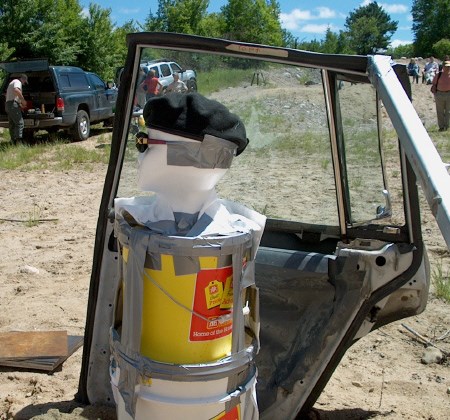The window and door protected by these blast cushions sustained no damage after being shot at with an elephant gun and other high-powered rifles. The bullets were unable to completely pass through the cushions.
The window and door protected by these blast cushions sustained no damage after being shot at with an elephant gun and other high-powered rifles.
The bullets were unable to completely pass through the cushions. Photo by Chris Dawson, Special to BayToday.ca.____________________________________________________________
Capt. Keith Cunningham (Ret.) tried his best this past weekend to shoot the living daylights out of Troy Hurtubise’s newest invention, the light infantry magnetic blast cushion.
But Cunningham didn’t have much success, even though he was using a scary arsenal of high-calibre rifles and ammunition.
“I was very impressed with these cushions, particularly with the way they handled the .375 bullets from my elephant gun,” said Cunningham, during an interview from his home in Burnt River, Ont.
“No matter what calibre bullet I used they just couldn’t fully penetrate the cushions.”
Herculean protectionHurtubise designed the cushions, made with specially treated Kevlar, ceramics, metal alloys and the force-absorbing system from his Ursus Mark-VII bear suit, to shield soldiers in Afghanistan and Iraq from roadside bombs that have already claimed military lives in both countries.
The cushions can be attached to jeeps, Humvees and other light personnel carriers using magnets. Passengers in the vehicles would also be able to sit on the cushions for added protection.
“They’re able to not only withstand bullets and explosions, but also provide protection from blunt trauma,” said Hurtubise, 39.
“It’s Herculean protection with simplicity.”
Intense punishmentTesting of the cushions was held Saturday at a gravel pit near Widdifield Station Road, and they readily survived intense punishment from ballistics and explosives.
Hurtubise built mannequins using wig heads and attaching them to 20-gallon pails. Each pail contained a mixture of water and blood-coloured dye to add graphic realism, Hurtubise said.
Each mannequin was put
behind a car door. Three of the four doors were unprotected,
while the fourth had blast cushions attached to it.
The unprotected doors were exploded and the mannequins behind them blown to smithereens.
incredibly impressedThen came the testing of the fourth door, which had the cushions attached to it.
“I shot some big bullets into them at point-blank range and then an explosive expert put dynamite on the cushions and tried to blow them up, but they survived,” said Cunningham, who spent 25 years with the Canadian Armed Forces and the American army, and now
teaches sharpshooting.
“I was incredibly impressed the way the cushions could absorb the shock from the charges set off right on top of them. And I hope people see this invention for what it is and delve into it further, because it could help anybody in any combat area where there are landmines or rocket-propelled grenades being used.”
Totally safeHurtubise said he named the protected marine Crazy Horse, in honour of the Sioux warrior who led the rout against General George Custer at Little Bighorn.
"Crazy Horse was told when he was 14 in his dream vision 'you will lead the fray in battle and never will you be touched by an arrow or a bullet.' That’s my marine, because there’s nothing that’s going to touch it," Hurtubise said.
"And nothing did, from start to finish, from the simple .308 sniper rifle to the powerful .223 penetrator, to the magnificent elephant gun all the way to the bombs, nothing touched my marine, he was totally safe, absolutely, and all the other marines were dead."
Sprained neckHurtubise said the explosive force used at some points was the equivalent of 10 hand grenades.
“But the door only ended up being dented, and if that had been a real situation with a real person in a light armoured vehicle protected by those cushions, that person would have survived, maybe with a sprained neck,” Hurtubise said.
He also said receiving Cunningham's endorsement held great significance.
“When Capt. Keith Cunningham says he’s impressed, you know he’s impressed,” Hurtubise said.
“The man’s been on two tours of Vietnam, he’s seen what bullets and bombs can do, the death, the destruction, the mayhem.”
Unable to commentA film crew from the Discovery Channel was on hand for the testing and will be airing its segment on Canadian television in September. An American film crew was also there, as part of a documentary being done about Hurtubise.
The Canadian military also sent a representative to witness the tests.
Capt. Mike Wionzek, the army staff officer responsible for armoured vehicle protection within the Directorate of Land Requirements, said he was unable to comment on anything he observed but added he will be preparing a report for his superiors which will include his recommendations.
Best dayHurtubise said the testing was “the best day of my life.”
"It couldn’t have gotten better than that I literally broke down and it brought tears to my eyes," Hurtubise said.
"You couldn’t have gotten better than this. to see what it did to that door, there was just a skeleton left, and looked like it got incinerated, and then you look at my door, nothing, just a big punch in it, and that marine is safe on the other side."
Different storyHurtubise said the cushions present the solution to the biggest problem facing the military today: terrorist attacks with rocket-propelled grenades.
"They’re taking Apache helicopters out, they’re taking planes out, they’re taking everything out because they’re so cheap, so easy to use, so accessible, so easy to hide, and we can’t stop them," Hurtubise said.
"Now we can. And if those trade centres had had two foot-thick panels of this stuff in them, I bet you it would have been a whole different story. The trade centres would have never fallen."



